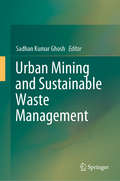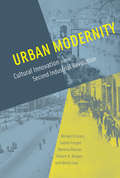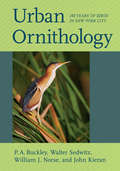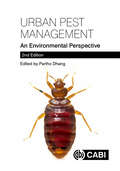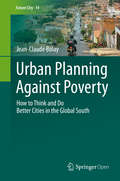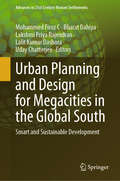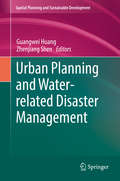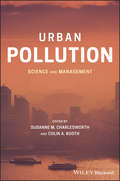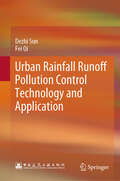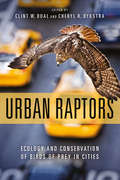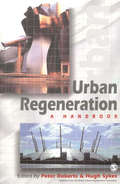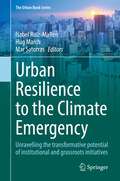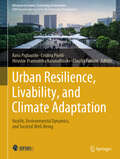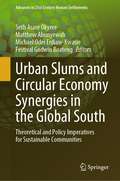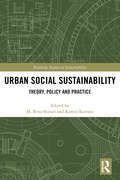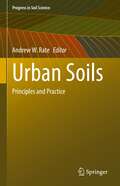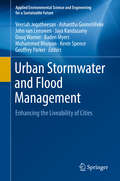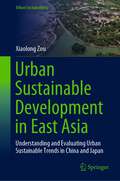- Table View
- List View
Urban Mining and Sustainable Waste Management
by Sadhan Kumar GhoshThis book gathers selected high-quality research papers presented at the IconSWM 2018 conference, which explore various aspects of urban mining. In addition, they discuss how to achieve sustainable waste management systems, urban mining, landfill mining, material recovery, circular economy, etc., with the aid of effective waste management practices. Additional topics covered include maximum resource circulation and efficiency, key differences between landfill mining and urban mining, and how urban mining can be combined with the concepts of circular economy and sustainability.
Urban Modernity: Cultural Innovation in the Second Industrial Revolution (The\mit Press Ser.)
by Morris Low Miriam R. Levin Sophie Forgan Martina Hessler Robert H. KargonHow Paris, London, Chicago, Berlin, and Tokyo created modernity through science and technology by means of urban planning, international expositions, and museums.At the close of the nineteenth century, industrialization and urbanization marked the end of the traditional understanding of society as rooted in agriculture. Urban Modernity examines the construction of an urban-centered, industrial-based culture—an entirely new social reality based on science and technology. The authors show that this invention of modernity was brought about through the efforts of urban elites—businessmen, industrialists, and officials—to establish new science- and technology-related institutions. International expositions, museums, and other such institutions and projects helped stem the economic and social instability fueled by industrialization, projecting the past and the future as part of a steady continuum of scientific and technical progress. The authors examine the dynamic connecting urban planning, museums, educational institutions, and expositions in Paris, London, Chicago, Berlin, and Tokyo from 1870 to 1930. In Third Republic Paris, politicians, administrators, social scientists, architects, and engineers implemented the future city through a series of commissions, agencies, and organizations; in rapidly expanding London, cultures of science and technology were both rooted in and constitutive of urban culture; in Chicago after the Great Fire, Commercial Club members pursued civic ideals through scientific and technological change; in Berlin, industry, scientific institutes, and the popularization of science helped create a modern metropolis; and in Meiji-era Tokyo (Edo), modernization and Westernization went hand in hand.
Urban Narratives: Exploring Identity, Heritage, and Sustainable Development in Cities (Advances in Science, Technology & Innovation)
by Gasim Hayder Ahmed Salih Mohd Fairuz Shahidan Alessio Cardaci Israa Hanafi MahmoudThis book engages readers in an enlightening exploration of cities' identities, sustainability, and urban development. Delving into the intricate interplay between art, architecture, and the urban landscape, it offers a compelling analysis of the factors that shape cities and their distinct personalities. The volume uncovers captivating stories of cities as they navigate the delicate balance between heritage conservation and modernity. It highlights innovative strategies employed to preserve historical sites while adapting to the demands of a rapidly changing world. Full of insightful discussions on the impact of cultural lifestyles, the fusion of architectural styles, and the challenges and triumphs of sustainable urban development, it draws upon a diverse range of perspectives and research, inviting architects, urban planners, and scholars to delve into the intricate nuances of cities' identities in the process.With its informative and engaging narrative, this book providesa fresh perspective on cities' identities and offers practical insights into shaping vibrant, livable urban landscapes.
Urban Ornithology: 150 Years of Birds in New York City
by P. A. Buckley Walter Sedwitz William J. Norse John KieranUrban Ornithology is the first quantitative historical analysis of any New York City natural area’s birdlife and spans the century and a half from 1872 to 2016. Only Manhattan’s Central and Brooklyn’s Prospect Parks have preliminary species lists, not revised since 1967, and the last book examining the birdlife of the entire New York City area is now more than fifty years old.This book updates the avifaunas of those two parks, the Bronx, and other New York City boroughs. It treats the 301 bird species known to have occurred within its study area—Van Cortlandt Park and the adjacent Northwest Bronx—plus 70 potential additions. Its 123 breeding species are tracked from 1872 and supplemented by quantitative breeding bird censuses from 1937 to 2015. Gains and losses of breeding species are discussed in light of an expanding New York City inexorably extinguishing unique habitats.
Urban Overheating: Heat Mitigation and the Impact on Health (Advances in Sustainability Science and Technology)
by Mat Santamouris Nasrin AghamohammadiThe book reviews and reports the recent progress and knowledge on the specific impact of current and projected urban overheating as well as of the urban mitigation technologies on mortality and morbidity and urban vulnerability. It presents recent data and developments on the topic reported by some of the more distinguished researchers in this area. In parallel, it discusses new findings related to the characteristics and the magnitude of urban overheating and reports and analyzes the recent knowledge on the synergies between urban heat island and heatwaves. This book helps to advance our understanding on the interaction between Urban Heat Island (UHI) and overheating as well as their impact on energy demand and public health globally. Exploring the interaction between UHI and energy consumption requires the understanding on the dynamics of UHI intensity and air pollution index in different land use and how such interactions may vary in different cities in the world. Moreover, this book focuses on different cities in Australia, Austria, Belgium, Brazil, Canada, Cyprus, Greece, Hong Kong, India, Asia, Spain, UK, and USA.
Urban Pest Management: An Environmental Perspective
by Edited by Partho DhangThe management and control of pests in the urban environment in the 21st Century faces many challenges. Pest populations adapt to changing conditions brought about by environmental changes caused by global warming, human population growth, and increased pollution. Urban pests are able to expand their ranges, densities, and habitats, sometimes causing large-scale damage and disease. This book provides collective insights from academic and industry experts on perspectives concerning urban pest management and regulatory innovations arising from the rapid onset of recent environmental challenges. Chapter topics address pest biology, advances in urban pest management practices, emerging urban pest control developments, new technologies, and regulations. The book describes new methods of pest control, their impacts on human health and the environment, and strategies for integrated management limiting the use of chemicals. It provides a practical resource for researchers and policy makers in pest management, urban health, medical entomology and environmental science. This title provides: An up-to-date and comprehensive resource on environmental urban pest management. A resource designed to appeal to pest control operators, public health professionals, and a range of field workers, as well as researching academics and graduate students. Insights from both academic and industry experts together in one volume.
Urban Planning Against Poverty: How to Think and Do Better Cities in the Global South (Future City #14)
by Jean-Claude BolayThis open access book revisits the theoretical foundations of urban planning and the application of these concepts and methods in the context of Southern countries by examining several case studies from different regions of the world. For instance, the case of Koudougou, a medium-sized city in one of the poorest countries in the world, Burkina Faso, with a population of 115.000 inhabitants, allows us to understand concretely which and how these deficiencies are translated in an African urban context. In contrast, the case of Nueve de Julio, intermediate city of 50.000 dwellers in the pampa Argentina, addresses the new forms of spatial fragmentation and social exclusion linked with agro export and crisis of the international markets. Case studies are also included for cities in Asia and Latin America. Differences and similarities between cases allow us to foresee alternative models of urban planning better adapted to tackle poverty and find efficient ways for more inclusive cities in developing and emerging countries, interacting several dimensions linked with high rates of urbanization: territorial fragmentation; environmental contamination; social disparities and exclusion, informal economy and habitat, urban governance and democracy.
Urban Planning and Design for Megacities in the Global South: Smart and Sustainable Development (Advances in 21st Century Human Settlements)
by Bharat Dahiya Lakshmi Priya Rajendran Uday Chatterjee Mohammed Firoz C Lalit Kumar DashoraThis anthology, Urban Planning and Design for Megacities in the Global South: Smart and Sustainable Development, sheds light on the intricate dynamics of megacity growth in the Global South. It has compiled a rich and diverse array of evidence-based case studies, fostering discussions on emerging issues, strategies, and solutions for the enhanced planning and development of megacities in the Global South. By delving into the underlying factors propelling this rapid urban expansion, such as economic opportunities, rural-to-urban migration, and natural population growth, this volume analyzes the complex interplay of socio-economic, environmental, and political forces shaping city-regional landscapes. Examining the growth of megacities offers invaluable insights into the challenges and opportunities associated with urbanization in the 21st century. Furthermore, some cities that have not yet achieved megacity status have also been included in this book to provide a comprehensive understanding of urban growth dynamics and the related factors influencing this growth. By studying these rapidly expanding cities, their challenges in urban planning and policy implementation can be identified. These challenges often include inadequate infrastructure, insufficient public services, environmental degradation, and socio-economic disparities. In response, using case studies, the book presents conceptual and empirical strategies to tackle the various problems faced by megacities of the Global South.
Urban Planning and Water-related Disaster Management (Strategies for Sustainability)
by Zhenjiang Shen Guangwei HuangUrban areas face daunting environmental, economic and social challenges that have increased in scope in recent years, especially given climate change and globalization. At the same time, cities provide exciting opportunities for growth and revitalization of local and national economies. The interplay of these challenges and opportunities create important tasks for policymakers and researchers. This book provides a new horizon for exploring solutions to urban problems, especially water-related disasters in urban areas. It is of a cross-disciplinary nature offering both new concepts and practices that will help to promote communication between urban planning communities and water management professionals in order to integrate water-related disaster management into spatial planning.
Urban Policy in the Framework of the 2030 Agenda: Balance and Perspectives from Latin America and Europe (The Urban Book Series)
by María Ángeles Huete García Adrián Rodríguez Miranda Vicente Ugalde Rafael Merinero RodríguezThe book provides comparative information about the materialization of the 2030 Agenda in urban policy in ten countries located in Europe and Latin America. The Declaration of Quito is the starting point for the implementation of SDGs into public policies in urban areas. However, there are fewer efforts to understand the impact that the 2030 Agenda and, specifically, the instruments developed for its application in cities. The information of each country is presented in relation to two aspects: the construction of a public policy style in each country and the results and impacts on urban public policies implemented in specific cities within the national frameworks. The first means the emergence of a public policy framework and its materialization in public policy instruments. In this regard, the book raises the following questions: To what extent have the SDGs come to generate a common framework for cities in the countries? And how Urban SDGs are translated to national urban policies? The second, results and impacts at the local level, is related to two aspects: a) substantive: the goals of the policy and b) procedural: management aspects related to the policy design, governance, and institutional capacity building.
Urban Pollution: Science and Management
by Colin A. Booth Susanne M. CharlesworthMultidisciplinary treatment of the urgent issues surrounding urban pollution worldwide Written by some of the top experts on the subject in the world, this book presents the diverse, complex and current themes of the urban pollution debate across the built environment, urban development and management continuum. It uniquely combines the science of urban pollution with associated policy that seeks to control it, and includes a comprehensive collection of international case studies showing the status of the problem worldwide. Urban Pollution: Science and Management is a multifaceted collection of chapters that address the contemporary concomitant issues of increasing urban living and associated issues with contamination by offering solutions specifically for the built environment. It covers: the impacts of urban pollution; historical urban pollution; evolution of air quality policy and management in urban areas; ground gases in urban environments; bioaccessibility of trace elements in urban environments; urban wastewater collection, treatment, and disposal; living green roofs; light pollution; river ecology; greywater recycling and reuse; containment of pollution from urban waste disposal sites; bioremediation in urban pollution mitigation; air quality monitoring; urban pollution in China and India; urban planning in sub–Saharan Africa and more. Deals with both the science and the relevant policy and management issues Examines the main sources of urban pollution Covers both first-world and developing world urban pollution issues Integrates the latest scientific research with practical case studies Deals with both legacy and emerging pollutants and their effects The integration of physical and environmental sciences, combined with social, economic and political sciences and the use of case studies makes Urban Pollution: Science and Management an incredibly useful resource for policy experts, scientists, engineers and those interested in the subject.
Urban Rainfall Runoff Pollution Control Technology and Application
by Fei Qi Dezhi SunThis book comprehensively presents rapid progress and development in urban rainfall runoff pollution control technology in China since the 11th Five-Year Plan period. It covers many aspects of the research including background summary, assessment methods, control technology, and various case studies to the validation of the control theory and the development of sponge city construction. The book appeals to scholars and graduates majoring in environmental engineering and water supply engineering. It is also suitable for practitioners engaged in urban drainage system.
Urban Raptors: Ecology and Conservation of Birds of Prey in Cities
by Clint W. Boal Cheryl R. DykstraRaptors are an unusual success story of wildness thriving in the heart of our cities—they have developed substantial populations around the world in recent decades. But there are deeper issues around how these birds make their urban homes. New research provides insight into the role of raptors as vital members of the urban ecosystem and future opportunities for protection, management, and environmental education.A cutting-edge synthesis of over two decades of scientific research, Urban Raptors is the first book to offer a complete overview of urban ecosystems in the context of bird-of-prey ecology and conservation. This comprehensive volume examines urban environments, explains why some species adapt to urban areas but others do not, and introduces modern research tools to help in the study of urban raptors. It also delves into climate change adaptation, human-wildlife conflict, and the unique risks birds of prey face in urban areas before concluding with real-world wildlife management case studies and suggestions for future research and conservation efforts.Boal and Dykstra have compiled the go-to single source of information on urban birds of prey. Among researchers, urban green space planners, wildlife management agencies, birders, and informed citizens alike, Urban Raptors will foster a greater understanding of birds of prey and an increased willingness to accommodate them as important members, not intruders, of our cities.
Urban Regeneration and Real Estate Development: Turning Real Estate Assets into Engines for Sustainable Socio-economic Progress (SpringerBriefs in Applied Sciences and Technology)
by Andrea Ciaramella Marco Dall'OrsoThe book reflects on how intelligent urban regeneration can be an extraordinary driver of sustainable social and economic progress. It provides a friendly, evergreen and flexible thinking methodology that can serve as a reference guide to address a wide range of initiatives creating the conditions to thrive in an increasingly selective, rapidly changing and unpredictable market context. The book throws light on the importance of adopting an open approach based on collaboration, crafting strong visions, developing appealing value propositions, embracing a modern leadership style and setting-up highly effective multi-disciplinary team for the execution. It illustrates how standard approaches should be re-designed, business models innovated and processes re-engineered to guarantee better alignment between supply and demand of real estate as markets shift and new differentiators emerge among competitors. The book makes clear that creating a vibrant urban ecosystem requires a gradual shift of focus from built-environment investment to socio-economic output. It targets a wide audience of private and public sector professionals active in urban regeneration and real estate development.
Urban Regeneration in the UK
by Andrew TallonThis textbook provides an accessible and critical synthesis of urban regeneration in the UK, incorporating key policies, approaches, issues, debates and case studies. The central objective of the textbook is to place the historical and contemporary regeneration agenda in context. Section I sets up the conceptual and policy framework for urban regeneration in the UK. Section II traces policies that have been adopted by central government to influence the social, economic and physical development of cities, including early town and country and housing initiatives, community-focused urban policies of the late 1960s, entrepreneurial property-led regeneration of the 1980s, competition for urban funds in the 1990s, urban renaissance and neighbourhood renewal policies of the late 1990s and 2000s, and new approaches in the age of austerity during the 2010s. Section III illustrates the key thematic policies and strategies that have been pursued by cities themselves, focusing particularly on improving economic competitiveness and tackling social disadvantage. Section IV summarises key issues and debates facing urban regeneration upon entering the 2020s, and speculates over future directions in an era of continued economic uncertainty. The Third Edition of Urban Regeneration in the UK combines the approaches taken by central government and cities themselves to regenerate urban areas. The latest ideas and examples from across disciplines and across the UK's urban areas are illustrated. This textbook provides a comprehensive and up-to-date synthesis that will be of interest to students, as well as a seminal read for practitioners and researchers.
Urban Regeneration: A Handbook
by Professor Peter Roberts Hugh Sykes`It [Urban Regeneration] Should make life somewhat easier for practitioners and will offer a further stimulus to the development of taught courses in the not-so-gentle art of regeneration' - Urban Studies Providing students and practitioners with a detailed overview of the key theoretical and applied issues, this book is a comprehensive and integrated primer on regeneration. The various chapters: review the history and context of urban regeneration; consider funding implications; look at environmental, social and community issues, as well as employment, education and training; focus on managing urban regeneration; consider land use issues; and discuss monitoring and evaluation. The book concludes with a comparative analysis, with examples from America and Europe, and a discussion of future trends. The book represents the first systematic overview of urban regeneration in one volume and is set to become the standard reference work. As such, it will be required reading for practitioners involved in regeneration, and students of urban studies, planning, architecture, and estate management.
Urban Resilience to the Climate Emergency: Unravelling the transformative potential of institutional and grassroots initiatives (The Urban Book Series)
by Isabel Ruiz-Mallén Hug March Mar SatorrasThis volume sheds light on urban resilience strategies in times of climate emergency and social and economic crisis by reflecting on related social vulnerabilities and inequalities within cities and showing the potential of participatory governance approaches for socio-environmental transformation. The book compiles critical research documenting the articulation of urban resilience strategies dealing with climatic changes, as well as the understanding of the unexpected implications of top-down resilience plans to address the impacts of climate change in cities, especially on the most vulnerable urban populations, and the transformative capacities of bottom-up and socially innovative resilience strategies. The book especially focuses on co-produced and grassroots transformative processes that are concerned with social equity in urban planning for climate change. Although several publications cover the topic of urban resilience, this book provides a more nuanced exploration of urban climate governance and citizen engagement in urban climate resilience policies through the lenses of political ecology, environmental justice and co-production. In this regard, the volume moves beyond the approach of multilevel urban climate governance by critically addressing the unexpected impacts of top-down strategies of urban resilience with the goal of expanding the reflection on citizen engagement. The book also explores the emerging possibilities behind the co-production of urban resilience as well as the critical role of grassroots and citizens in promoting such alternative strategies. While the primary target audience is scholars from different disciplines (e.g. geography, urban studies, planning, political ecology, architecture, urban sociology, environmental studies) focusing on urban resilience, the editors also aim to reach urban resilience practitioners from local, national and international organisations as well as environmental grassroots and climate activists.
Urban Resilience, Livability, and Climate Adaptation: Health, Environmental Dynamics, and Societal Well-Being (Advances in Science, Technology & Innovation)
by Cristina Piselli Claudia Fabiani Hirushie Pramuditha Karunathilake Ilaria PigliautileThis book explores urban environments and their impact on resilience, livability, climate adaptation, health, and societal well-being. It provides interdisciplinary insights for fostering resilient, livable, and sustainable cities prioritizing well-being and quality of life for all residents. The book covers various topics and discusses innovative approaches for incorporating nature into urban planning. It also examines the relationships between diet diversity, food environments, and transportation systems. Spatial analysis of noise contour maps based on traffic speed is conducted, along with an assessment of the impact of office environments on productivity. The book explores the influence of streetscapes on anxiety, envisions future cities from a youth perspective, and identifies critical factors affecting the design and use of elevated urban spaces. Daylighting performance in school expansions is evaluated, and the concept ofa livable city is examined. Community adaptive capacity for climate-resilient development is assessed through a case study analysis. The livability of street vendors in different urban contexts is compared, and alternative perspectives on restorative environments are presented. The book investigates the impact of urban refugees on cities and reevaluates scientific theories for human well-being-oriented built environments. It evaluates tourist satisfaction with urban railway systems and explores sport as a tool for healthy and sustainable cities.
Urban Services to Ecosystems: Green Infrastructure Benefits from the Landscape to the Urban Scale (Future City #17)
by Maria Beatrice Andreucci Chiara Catalano Riccardo Guarino Francesca Bretzel Manfredi Leone Salvatore PastaThe aim of this book is to bring together multidisciplinary research in the field of green infrastructure design, construction and ecology. The main core of the volume is constituted by contributions dealing with green infrastructure, vegetation science, nature-based solutions and sustainable urban development. The green infrastructure and its ecosystem services, indeed, are gaining space in both political agendas and academic research. However, the attention is focused on the services that nature is giving for free to and for human health and survival. What if we start to see things from another perspective? Our actions shall converge for instance to turn man-made environment like cities from heterotrophic to autotrophic ecosystems. From landscape ecology to urban and building design, like bricks of a wall, from the small scale to the bigger landscape scale via ecological networks and corridors, we should start answering these questions: what are the services that are we offering to Nature? What are we improving? How to implement our actions? This book contains three Open Access chapters, which are licensed under the terms of the Creative Commons Attribution 4.0 International License (CC BY 4.0).
Urban Slums and Circular Economy Synergies in the Global South: Theoretical and Policy Imperatives for Sustainable Communities (Advances in 21st Century Human Settlements)
by Michael Odei Erdiaw-Kwasie Seth Asare Okyere Matthew Abunyewah Festival Godwin BoatengThis book takes a theoretical and empirical distance from urban slums/low-income settlements as a threat to environmental sustainability and recast them as places where environmentally rehabilitative and circular practices occur—drawing on the theoretical lens of the circular economy (CE). CE is defined as regenerative system that minimizes waste, emission, and energy leakage by slowing, closing, and narrowing material and energy loops. In principle, CE departs from the traditional linear model of take-make-use-dispose. As conceived in urban contexts, circular cities offer possibilities to regenerate natural systems, design out waste, and keep products in use. While the CE key principles of reduce, repair, and reuse are essential to the sustainable and inclusive interventions in urban slums, there is lack of case studies exploring the role of place and agency, especially the slum living-CE nexus in global south contexts. In inequitable urban transitions, a nuanced understanding of thesynergies between urban slums and the circular economy is not only theoretically relevant for reconceptualizing the slum in urban sustainability discourses but also exert policy and practice ramifications to decidedly figure out how the urban slum phenomenon can foster the sustainable and inclusive development of marginal areas through contextual and people-centered initiatives.
Urban Social Sustainability: Theory, Policy and Practice (Routledge Studies in Sustainability)
by Ramin Keivani M. ShiraziThis ground breaking volume raises radical critiques and proposes innovative solutions for social sustainability in the built environment. Urban Social Sustainability provides an in-depth insight into the discourse and argues that every urban intervention has a social sustainability dimension that needs to be taken into consideration, and incorporated into a comprehensive and cohesive ‘urban agenda’ that is built on three principles of recognition, integration, and monitoring. This should be achieved through a dialogical and reflexive process of decision-making. To achieve sustainable communities, social sustainability should form the basis of a constructive dialogue and be interlinked with other areas of sustainable development. This book underlines the urgency of approaching social sustainability as an urban agenda and goes on to make suggestions about its formulation. Urban Social Sustainability consists of original contributions from academics and experts within the field and explores the significance of social sustainability from different perspectives. Areas covered include urban policy, transportation and mobility, urban space and architectural form, housing, urban heritage, neighbourhood development, and urban governance. Drawing on case studies from a number of countries and world regions the book presents a multifaceted and interdisciplinary understanding from social sustainability in urban settings, and provides practitioners and policy makers with innovative recommendations to achieve more socially sustainable urban environment.
Urban Soils (Advances in Soil Science)
by Rattan Lal B. A. StewartGlobally, 30% of the world population lived in urban areas in 1950, 54% in 2016 and 66% projected by 2050. The most urbanized regions include North America, Latin America, and Europe. Urban encroachment depletes soil carbon and the aboveground biomass carbon pools, enhancing the flux of carbon from soil and vegetation into the atmosphere. Thus, urbanization has exacerbated ecological and environmental problems. Urban soils are composed of geological material that has been drastically disturbed by anthropogenic activities and compromised their role in the production of food, aesthetics of residential areas, and pollutant dynamics. Properties of urban soils are normally not favorable to plant growth—the soils are contaminated by heavy metals and are compacted and sealed. Therefore, the quality of urban soils must be restored to make use of this valuable resource for delivery of essential ecosystem services (e.g., food, water and air quality, carbon sequestration, temperature moderation, biodiversity). Part of the Advances in Soil Sciences Series, Urban Soils explains properties of urban soils; assesses the effects of urbanization on the cycling of carbon, nitrogen, and water and the impacts of management of urban soils, soil restoration, urban agriculture, and food security; evaluates ecosystem services provisioned by urban soils, and describes synthetic and artificial soils.
Urban Soils: Principles and Practice (Progress in Soil Science)
by Andrew W. RateThis textbook addresses the increasing trend in urbanization of the world’s population and its relation with urban soils. Written by active practitioners of university level teaching and research, this book is designed primarily as an educational text, while it also provides readers with an authoritative gateway to the primary literature. It includes explicit coverage of spatial and statistical (multivariate) techniques and case studies to illustrate key concept, and to support practical guidance in issues such as data collection and analysis. The authors reflect current developments in research and urban trends. In China, for example, the proportion of the population living in cities increased from 13% in 1950 to 45% in 2010 (World Bank data). Australia is one of the world's top ten urbanised countries with population greater than ten million, with approximately 90% of its population living in cities, mainly along Australia's coast. The most rapidly urbanising populations are currently in nations of the African continent. Soils in urban areas have multiple functions which are becoming more valued by urban communities: soils supply water, nutrients and physical support for urban plant and animal communities (parks, reserves, gardens), and are becoming increasingly valued for growing food. Soils may be used for building foundations, or as building materials themselves. Urban hydrology relies on the existence of unsealed soils for aquifer protection and flood control. This volume presents the importance of urban ecosystems and the impacts of global change. It examines pedogenesis of urban soils: natural materials affected by urban phenomena, and natural processes acting on urban materials, including an examination of different climatic zones. There is a focus on soils formed on landfill, reclaimed land, dredge spoils as well as soil-related changes in urban geomorphology. There is plenty of discussion on urban soil as a source and sink as well as soil geochemistry and health. The book is intended primarily as a text for upper-level undergraduate, and postgraduate (Masters) students. It will also be invaluable as a resource for professionals such as researchers, environmental regulators, and environmental consultants.
Urban Stormwater and Flood Management: Enhancing the Liveability of Cities (Applied Environmental Science and Engineering for a Sustainable Future)
by Geoffrey Parker Ashantha Goonetilleke Veeriah Jegatheesan John Van Leeuwen Jaya Kandasamy Doug Warner Baden Myers Muhammed Bhuiyan Kevin SpenceThis book brings together the experiences of engineers and scientists from Australia and the United Kingdom providing the current status on the management of stormwater and flooding in urban areas and suggesting ways forward. It forms a basis for the development of a framework for the implementation of integrated and optimised storm water management strategies and aims to mitigate the adverse impacts of the expanding urban water footprint. Among other topics it also features management styles of stormwater and flooding and describes biodiversity and ecosystem services in relation to the management of stormwater and the mitigation of floods. Furthermore, it places an emphasis on sustainable storm water management measures. Population growth, urbanisation and climate change will pose significant challenges to engineers, scientists, medical practitioners, policy makers and practitioners of several other disciplines. If we consider environmental and water engineers, they will have to face challenges in designing smart and efficient water systems which are robust and resilient to overcome shrinking green spaces, increased urban heat islands, damages to natural waterways due to flooding caused by increased stormwater flow. This work provides valuable information for practitioners and students at both senior undergraduate and postgraduate levels.
Urban Sustainable Development in East Asia: Understanding and Evaluating Urban Sustainable Trends in China and Japan (Urban Sustainability)
by Xiaolong ZouThis book offers careful glimpse from the lenses of selected case studies of major counties in East Asia, namely China and Japan to obtain insights as well as lessons regarding their perspective sustainable cities development. Urban sustainability is the pillar domain for achieving overall sustainability. East Asia has the world most populous countries and cities; therefore, it is of great importance to understand, analyze, and assess the sustainable urban development trends and paradigms in an East Asia setting so as to better guide the future development of sustainable cities in the region. The outcomes of this book are policy-relevant consultations to key stakeholders from various walks of sustainability studies.
